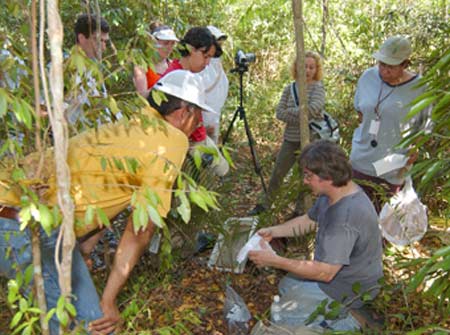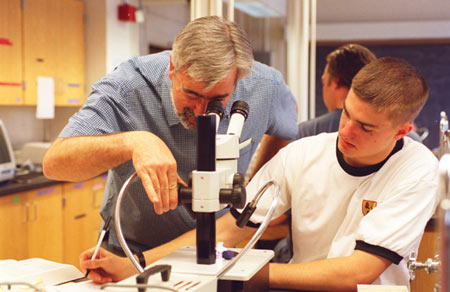Harvard students build Dominican insect database
Farrell class combines high technology, fieldwork to jump start national collection

It was dark driving down the Dominican Republic’s narrow roads at 3 o’clock in the morning. It was dark hiking into the Parque Nacional del Este, negotiating dirt trails by flashlight on an expedition to collect insects from the forest canopy above.
It was dark, but the activities of a group of Harvard students, faculty, and staff that night helped illuminate some of the unknown creatures of Hispaniola, an island designated by Conservation International — along with the rest of the Caribbean — as one of the world’s most threatened biodiversity hotspots.
The early morning excursion was part of a unique but powerful marriage of digital technology and old-fashioned fieldwork put together by Harvard biology professor Brian Farrell, curator in entomology at the Museum of Comparative Zoology. After six months’ planning, Farrell took a group of undergraduate and graduate students enrolled in his Tropical Insect Systematics class for a tropical spring break week that involved not only bug collecting, but also identifying, photographing, and preserving the specimens.

Over the course of the week, the group collected specimens representing 500 insect species, including perhaps 200 new ones, and helped establish a digital insect database for the Museo Nacional de Historia Natural in Santo Domingo. They left behind computers, bar-coding equipment, and specimen trays full of newly documented insects.
They also left behind a substantial gift to the museum’s scientific library: 5,000 pages of relevant but rare scientific literature contained on 29 compact discs. (All materials were at least 75 years old and thus out of copyright.)
The group left Harvard on March 22. Arriving in Santo Domingo, they stayed in the island nation for eight days, dividing their time between collecting, identifying, and setting up the database. Farrell said the group of 25 included his students, teaching assistant Bruce Archibald, three staff members from the Museum of Comparative Zoology, and entomology experts from the Museo Nacional de Historia Natural.
During the course of the week, the group used various insect-collecting techniques, including the nighttime excursion to fog the canopy with a biodegradable insecticide in order to collect species from the tree tops.
Several students said the fogging activity, in which the insects affected by the pesticide fell from high in the trees onto a large cloth suspended below, left the biggest impression during a week of big impressions.
“It was really incredible to be part of such a neat project,” said Chris Lamie, a sophomore concentrating in environmental science and public policy. “It was really exciting to feel you’re on the cutting edge.”
David Hembry, a junior biology concentrator, said the trip affirmed his love of biology. The trip was Hembry’s first to the tropics, and he said he was excited to see the many unusual plants, animals, insects, and marine life that he found on the trip.
“This is exactly the kind of thing I want to do,” Hembry said. “It was fantastic, a really eye-opening experience. It really whet my appetite to do fieldwork.”
The trip was a collaboration between several organizations and many individuals, Farrell said. His Dominican colleagues helped teach the students about the local insect life, and the students and MCZ staff, in turn, explained and helped set up digital databases that can be used for the Museo’s entire 55,000-specimen collection and that can expanded to accommodate future collections. Farrell said that within five years, the Dominican Republic will likely be the only nation with its entire insect fauna, complete with maps and images, available online.
The trip was sponsored by the Department of Organismal and Evolutionary Biology, the Fundacion Ecologica Punta Cana, and the David Rockefeller Center for Latin American Studies.
Students prepared for the trip during the eight weeks leading up to spring break. They learned the different insect groups and studied what characteristics tell them apart. Once in the Dominican Republic, the students broke into small groups of two or three, including a Dominican colleague, each responsible for identifying a particular insect type.
Farrell said it was “humbling” how the students threw themselves into the work, eagerly working into the night, either in the field or in the lab. Knowing that they were benefiting the Dominican national museum inspired their efforts.
“The amazing thing was this was service learning. These guys were working until 3 a.m. It was humbling,” Farrell said. “It was quite a transformation for them.”
Though the trip took six months to prepare, it’s been on the drawing board in Farrell’s mind for about 10 years, he said. The seeds were planted when he took [a] trips to the Amazon as a graduate student at the University of Maryland, working at the Smithsonian Institution. The idea got a further boost when he was an assistant professor at the University of Colorado and took his classes over spring break to the Sea of Cortez, off Mexico’s Baja California.
Now that he’s managed to pull the trip off, Farrell said he plans to make it part of the course, which will be offered every other year. Each trip, he said, will explore the insect fauna of another Dominican habitat, from mountains to the deserts to the coast. In addition, he plans to offer linked opportunities to for those interested in independent study.
Farrell himself will continue the work while he’s on sabbatical next year, examining Dominican bark beetles — a major pest to logging operations — with the help of a $450,000 grant from the National Science Foundation. The grant has been awarded to Farrell and colleagues from the Smithsonian and Carnegie Institutions to complete a plant and insect inventory of Hispaniola.
Now that they’re back, the students are engaged in compiling digital field guides to the categories of insects they worked on while in the Dominican Republic. Those guides are part of the lasting effects of the trip, Farrell said, as they will be available online to Dominican high school students, who can print them out and take them out into the field to do their own collecting and identifying.
“It was spectacular,” Farrell said. “It was just the most amazing experience I’ve been on.”




